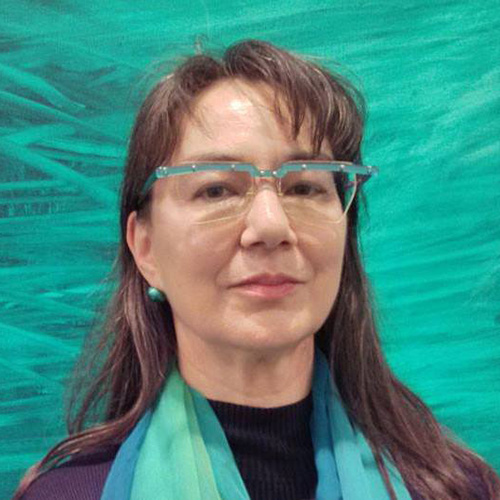
Tamiko Thiel
Tamiko Thiel is an internationally recognized digital media artist who explores the interplay of place, space, the body and cultural identity in works encompassing a supercomputer, objects, digital prints, videos, interactive 3d virtual worlds (VR), and augmented reality as both gallery installations and as art in public space.
Thiel received her B.S. in 1979 from Stanford University in Product Design Engineering, with an emphasis on human factors. She has an M.S. in Mechanical Engineering in 1983 from the Massachusetts Institute of Technology (MIT), with a focus on human-machine design at the Biomechanics Lab and computer graphics at the precursors to the MIT Media Lab. She then earned a Diploma (Master of Arts equivalent) in Applied Graphics in 1991 from the Academy of Fine Arts in Munich, Germany, specializing in video installation art.
Her first artwork, the visual design for the Connection Machine CM-1/CM-2 artificial intelligence supercomputer (1986/1987, and in 1989 the fastest machine in the world) is in the collections of the Museum of Modern Art New York and the Smithsonian Institution. Her early media art, including video from 1991 and virtual reality from 2000, are in collections of the ZKM Karlsruhe, the San Jose Museum of Art, and the Rose Goldsen Archive of New Media Art at Cornell University.
Her work has been exhibited internationally in venues such as the Museum of Modern Art (MoMA) and the Whitney Museum of American Art in New York, the Istanbul Biennial, the International Center for Photography New York, the Design Museum in the Pinakothek der Moderne Munich, the Institute of Contemporary Art London and Boston, the ZKM in Karlsruhe, the Tokyo Metropolitan Museum of Photography, the Fondazione Querini Stampalia in Venice and the Centre Pompidou in Paris.
A founding member of the cyberartist group Manifest.AR, she participated in the pathbreaking augmented reality (AR) intervention “We AR in MoMA,” an uninvited guerilla takeover of MoMA New York, in 2010. Thiel’s ARt Critic Face Matrix at MoMA was featured in articles in the New York Times and on WNYC (National Public Radio). In 2011 she led the Manifest.AR Venice Biennial AR Intervention, placing her work series Shades of Absence in St Marks Place and the Venice Giardini. This led to an invitation to participate in the ISEA UNCONTAINABLE official parallel program to the 2011 Istanbul Biennial and to the ZERO1 Biennial in Silicon Valley, USA.
Also in 2018, the Whitney Museum NY commissioned the AR installation Unexpected Growth (with /p), a dystopian coral reef formed of (virtual) plastic waste that bleaches in response to the number of people viewing it, and will bring it into their collection. In 2017 she was Google VR Tilt Brush artist in residence, created the VR artwork Land of Cloud, winner of the 2018 People’s Choice Award at the VRHAM VR festival in Hamburg. Thiel was awarded the 2018 iX Immersive Experiences Visionary Pioneer Award for her life work by the Society for Art and Technology Montreal In 2017 she was also an Eyebeam New York Art and Technology Center Mentor, and part of a Boston Cyberarts commission “The Augmented Landscape” funded by the NEA. She was a 2013 Macdowell Colony fellow, and from 2013-2016 as Artistic Advisor for the Caribbean Cultural Center/African Diaspora Institute she helped win a grant from the Rockefeller Foundation Cultural Innovation Fund for Mi Querido Barrio, an AR project in East Harlem. Earlier awards and fellowships include the IBM Innovation Award for Artistic Creation in Art and Technology, Art Council England, Wellcome Trust, WIRED Magazine, M.I.T, Japan Foundation and the Berlin Capital City Cultural Fund.
Thiel has collaborated with many notable partners, including AI inventor Danny Hillis and Nobel physicist Richard Feynman on the Connection Machine supercomputer and film director Steven Spielberg on Starbright World (1994- 1997), an online virtual reality playspace for seriously ill children. In 2014 she collaborated with psychiatrist Dr.Dominic ffytche of King’s College London on Fractured Visions (2014), an AR installation on visual disorders that make objects and textures seem to fragment and repeat across the visual field.
Thiel has taught and lectured internationally at Carnegie Mellon University, the MIT Media Lab, the Bauhaus- University Weimar/Germany, University of California San Diego, University of Southern California School of Cinema-Television, the Berlin University of the Arts and the Nanyang Technological University School of Art, Design and Media in Singapore. In 2018 she was visiting professor of AR and VR at the University of Art and Design in Linz and the University of Applied Sciences of Upper Austria/Hagenberg.
